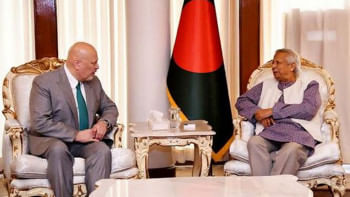Call money rate falls to record low amid tepid demand

The call money rate has plummeted to a record low, indicating the market is flush with liquidity with hardly any demand for credit.
Data shows the weighted average call money rate was 8.16 percent in 1997, which came down to 7.37 percent in 2007. The rate fell to 3.5 percent in July this year.
The call money rate is the rate at which banks lend overnight money to each other to fill the asset liability mismatch or to meet sudden demand for funds. The market was introduced in the country in the early 1980s.
The demand and supply of liquidity affect the call money rate: a tight liquidity condition leads to an increase in the call money rate and excess funds push the rate down.
Heavy government borrowing from the public via savings instruments, which are much higher yielding schemes, is a major reason for the banking sector's excess liquidity, said Anis A Khan, managing director of Mutual Trust Bank.
“Thus, the government does not need to borrow as much from the banks anymore -- its borrowing from the banking system has plummeted to a historical low in the last few years.”
Also, a substantial inflow of foreign funds has lessened local borrowings by large corporate bodies, said Khan, also the chairman of Association of Bankers Bangladesh.
Though the private sector credit grew 16.5 percent in June this year, it did not help banks condense their excess liquidity, as most of the loans were short-term ones, bankers said.
Banks are relying on the Bangladesh Bank Bills, which yield less than 3 percent in interest rate, to invest their money.
In the last six months, the central bank mopped up Tk 24,000 crore through the system to minimise the growing liquidity in the market.
When there is surplus liquidity in the system, the call money rate tends to move closer to the fixed reverse repo rate.
Now, the reverse repo rate, which tends to be somewhat conservative in Bangladesh, yields more than the overnight money market.
The interest rate on reverse repo has remained unchanged at 5.25 percent since February 2013.
Reverse repo is the rate at which banks park their excess funds with the BB -- the last option when no other avenues are available for investing excess money.
But the BB did not accept any bid for reverse repo since November last year.
“Poor demand for loans is the main reason for the building liquidity in the banking system,” said a treasury official of Prime Bank.
Government borrowing from the banking sector has also declined in the wake of record sales of savings tools, he added.
The net sale of different savings schemes rose to about Tk 33,689 crore, which was the highest in the country's history, against a government target of Tk 15,000 crore for fiscal 2015-16.
Investors were lured in by interest rates as high as 5 percentage points more than those offered by commercial banks on term deposits.
On the other hand, the government borrowed only around Tk 4,000 crore from the banking system against a target of Tk 38,523 crore for fiscal 2015-16.
“Low-cost loans from foreign sources taken by local entrepreneurs are also squeezing local banks' scope to lend,” said a treasury official of Mercantile Bank.
Though the central bank recently imposed restrictions on foreign loans, entrepreneurs have availed over $8 billion in loans from foreign sources between 2012 and 2015.
NBFIs, which are major borrowers in Bangladesh's call money market, are not as active now as the investment scope is absent.
“Why would we borrow from the market if it remains unutilised?” asked Mafizuddin Sarker, chairman of Bangladesh Leasing and Finance Companies' Association.


 For all latest news, follow The Daily Star's Google News channel.
For all latest news, follow The Daily Star's Google News channel. 



Comments